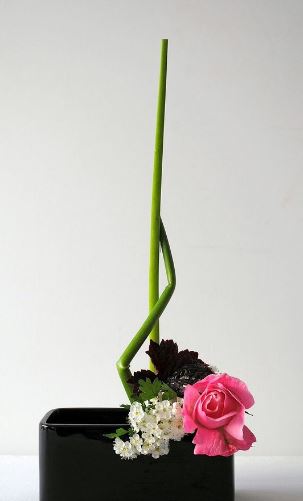 Ikebana is a Japanese style of floral design. Ikebana dates back over five centuries when it was introduced to Japan when Buddhists arrived in the country and was used to worship at Buddhist altars. Today it continues to be practised as a highly respected cultural art form in modern-day Japan.
Ikebana is a Japanese style of floral design. Ikebana dates back over five centuries when it was introduced to Japan when Buddhists arrived in the country and was used to worship at Buddhist altars. Today it continues to be practised as a highly respected cultural art form in modern-day Japan.
Unlike western floral designs that emphasize the color and bloom of different flowers, Ikebana pays attention to the overall line and form of all plant material used and emphasizes minimalism and asymmetry. Ikebana also reveres the sacred relationship between man and nature with the flower arrangement usually practised in a silent and meditative state.
In classical schools, lines and nature are paramount; in some modern schools, individual creativity is more important. Serious devotees spend years practicing and perfecting this classical Japanese art form, so it is generally agreed that Ikebana requires more effort and patience than dropping a grocery store bouquet into the nearest vase.
However, you can have fun doing your ikebana flower arrangement as ikebana also delights in unexpected spontaneity as well.
The schools of ikebana
Ikebana has over 2000 schools of thought, philosophies, and styles with their respective rules for proper ratios and approaches. Consider finding an ikebana class online to find the school that suits your personality best. The following are the largest and most popular:
Ikenobo School
Ikenobo is the original school of ikebana. The beauty of a natural landscape (rikka style) and the essential character of a plant’s natural environment (shoka style) are just two of the themes of this classical school.
Ohara School
Founded in the late nineteenth century, the Ohara school incorporates influences from the western world. Breaking with tradition, the Ikebana Master Mr. Ohara created a new container, wide and shallow, to accommodate his new style, called moribana.
Sogetsu School
Founded in Japan in 1927 by Sofu Teshigahara, the motto of this modern school is “Anyone can make ikebana, any material can be used, and arrangements can be placed anywhere,” These creative free style arrangements use exotic flowers and non-plant materials.
Ichiyo School
Founded in 1937 this modern school uses personal interpretation and imagination in their free style arrangements to arouse the senses. It is suggested that ikebana from this school gives viewers a more unexpected and profound experience of nature.
Chiko School
Founded in 1927 by Kao Naruse, this school created the style known as morimono. Fruit, vegetable, dolls or other objects are combined with floral materials and linked with sand sprinkled at the base to create harmony.
Enshu School
Founded in the late fifteenth century, this traditional and classical school follows an elegant ancient style composed of gracefully curving lines.
How can I learn ikebana?
Practitioners in many of the ikebana schools hold classes throughout the world. With 165 chartered chapters in over 50 countries with 8,500 members worldwide, local chapters can help guide you to the right teacher.
Beginner level classes usually begin with students learning about the unique design principles, methods and styles of Ikebana from a particular school. Using plant materials and, in modern arrangements non-living elements, you will be helped to create an artistic piece. By creating their own arrangement in class and having it critiqued, students learn about lines, shapes, textures and colors just like any work of art. Ikebana also has a spiritual element, as practitioners undertake the process in silence in order to reconnect internally and to nature.
For inspiration, view the Japanese American National Museum’s amazing photo collection of different ikebana flower arrangements.



